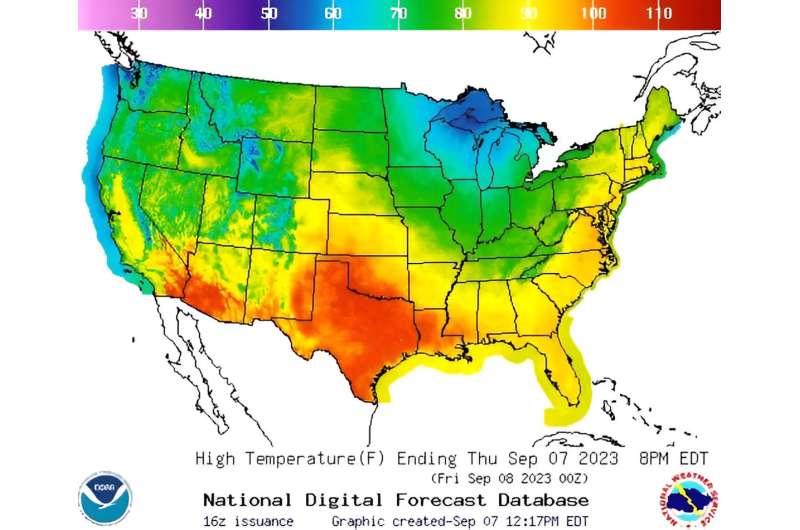This article has been reviewed according to Science X's editorial process and policies. Editors have highlighted the following attributes while ensuring the content's credibility:
fact-checked
trusted source
proofread
Temperature-related deaths could rise five-fold by the end of this century in the US

If global temperatures warm 3 degrees Celsius (5.4 degrees Fahrenheit) above pre-industrial averages and cities do not expand their existing cooling infrastructure, the United States can expect five times the number of temperature-related deaths per year, a new study finds. Adapting cities to heat, primarily through greatly expanded access to air conditioning in the northern states, could slow that trend by 28%.
Population growth and the expanding share of the population age 75 and older drives most of the increase in number of deaths from heat and cold, according to the study, published this week in GeoHealth. People over the age of 75 are ten times more vulnerable to heat and cold than younger adults, according the researchers, so as the U.S. population ages, a larger proportion of residents will be at risk.
The effects of climate change alone contribute little to the overall loss of life from temperature-related health impacts in the United States as a whole—until the 3-degree threshold is crossed.
"We find that in the future, temperature-related deaths are going to increase in the northern U.S., mostly due to an increase in heat-related deaths," said Jangho Lee, a climate scientist at the University of Illinois and lead author of the study. "That's because southern cities, like Phoenix or Houston, are already very well adapted to heat, whereas northern cities are not."
Warmer winters are reducing the number of cold-related deaths, but rising mortality due to excessive heat is offsetting the lives saved. The study predicted this balance will continue until global temperature averages cross 3 degrees Celsius of warming, an inflection point when heat-related deaths can be expected to rise rapidly, causing overall temperature-related deaths to rise.
If current carbon emissions continue unchecked, that temperature tipping point could be reached by the end of the century.
"Because cold kills more people in the U.S. than heat, some people argue that climate change will save more lives from fewer cold temperatures than we will lose from more hot temperatures," said Andrew Dessler, a climate scientist at Texas A&M University and an author of the new study. "But that's not what we found. It's not going to save a lot of lives. It's basically a wash in the in the U.S., up until about 3 degrees warming, and then it depends on your level of adaptation."
The study drew on data from 106 U.S. cities, about 65% of the U.S. population, from 1987 to 2000, finding on average 36,444 temperature-related deaths per year: 4,819 from heat and 31,625 (85%) from cold. About 75% of people who succumbed to either heat or cold were over the age of 75, a group that made up only 5% of the population over the study period.
The study projected that without adaptation to heat, the combination of warming climate and an increasing and aging population would cause temperature-related deaths in these cities to reach 200,000 per year at 3 degrees Celsius of global average warming. Adaptation across the United States to the same extent as the most heat-ready cities could reduce this toll by 28%, to 144,000.
Surprisingly, most cold-related deaths occur in relatively mild temperatures, well above freezing and in many cases only 5 degrees Celsius (9 degrees Fahrenheit) below ideal conditions, which is 22 degrees Celsius (72 degrees Fahrenheit) in most locations. Heat-related deaths, in contrast, are more strongly associated with extreme heat events.
The study predicts decreases in exposure to moderately cold temperatures will save the most lives in a warming climate. At the same time, extreme temperatures responsible for the greatest increase in mortality were predicted to have a minor impact in southern cities, where most residents already have access to some air conditioning. The combination pushes the burden of lives lost to the north.
Northern Midwestern cities Minneapolis, Milwaukee and Muskegon, Michigan, are expected to experience the greatest temperature jumps of the cities included in the study (0.96, 0.88 and 0.86 degrees larger than the global average respectively).
"We cannot really project how people will adapt in the future. We don't know how policies are going to change, we don't know how much money we're going to spend. So we come up came up with two limiting scenarios of adaptation. One is no adaptation at all, and one another is the full adaptation," Lee said. Full adaptation, he explained, means warmer future cities would adopt the cooling infrastructure of more southern locations that experience similar temperature ranges now.
Dessler cautions the situation in the United States, a wealthy country with perhaps the highest capacity in the world to buy temperature relief, cannot be extrapolated everywhere. In the tropics, death from cold is uncommon, he said, and many countries are already struggling to manage current temperatures. These regions will not see benefits, only rising heat stress.
"Air conditioning is expensive," Dessler said. "People who don't have it today or live in an under-air-conditioned world where they can only run the air conditioner for an hour or two—it's going to be hard for them to adapt."
More information: Jangho Lee et al, Future Temperature‐Related Deaths in the U.S.: The Impact of Climate Change, Demographics, and Adaptation, GeoHealth (2023). DOI: 10.1029/2023GH000799





















